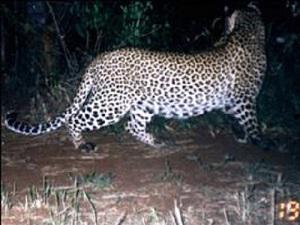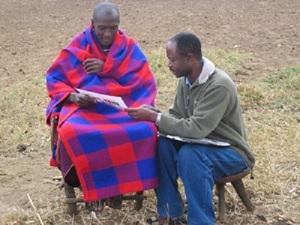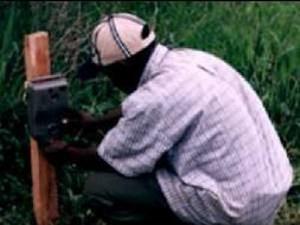Maurus Msuha
This project seeks to build capacity for large carnivore conservation in the Masai steppe, northern Tanzania by (i) training Village Game Scouts and Game Rangers in carnivore identification and monitoring techniques in order to develop capacity for large carnivore monitoring, (ii) determining large carnivore distribution in order to identify priority areas for conservation, (ii) assessing attitudes of local people towards large carnivores in order to understand key factors that affect people’s tolerance to large carnivores, (iv) carry out outreach program to raise awareness on large carnivore conservation.

Leopard caught in camera trap.
Conservation of large carnivore present an enormous challenge, partly because they require large and intact habitats to survive. Such habitats are increasingly becoming difficult to find due to human pressure. Large carnivores are also difficult to study and therefore for most species very little is known about them that can help guide conservation planning. Furthermore, large carnivore can prey on livestock and attack people hence generating negative attitudes towards their conservation. However, their conservation can be important in many ways e.g. they are part of many ecosystems and are good indicators of a heathy ecosystem. Being at the top of the food chain, their presence in ecosystems is important e.g. for regulating prey numbers, and their relationship with prey and each other can influence population dynamics, behaviour and evolutionary processes in ecosystems. Removal of top predators often results in changes in biodiversity and community structure, and can have severe consequences on ecosystem concerned.

Maurus doing interviews.
Without carnivores, densities of prey may fluctuate; ungulate numbers can rise during favourable times and decline during poor times which can cause changes in vegetation and community structure, and affect ecosystem services such as water supply. Large carnivores are also used as flagships for conservation planning; they are also charismatic and hence can attract tourists and provide economic benefits to communities particularly in developing countries such as Tanzania.

Trainee setting camera traps.
This project seeks to build capacity for large carnivore conservation in the Masai steppe, northern Tanzania by:
(i) training Village Game Scouts and Game Rangers in carnivore identification and monitoring techniques in order to develop capacity for large carnivore monitoring
(ii) determining large carnivore distribution in order to identify priority areas for conservation,
(iii) assessing attitudes of local people towards large carnivores in order to understand key factors that affect people’s tolerance to large carnivores
(iv) carry out outreach program to raise awareness on large carnivore conservation.